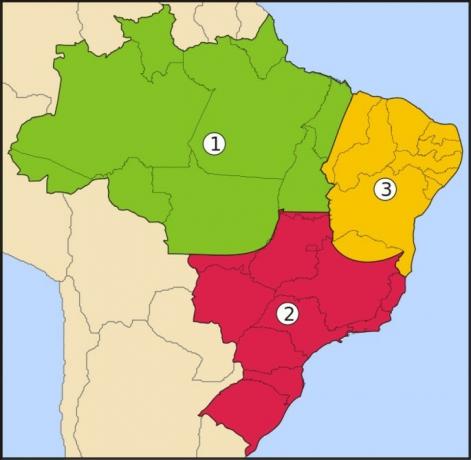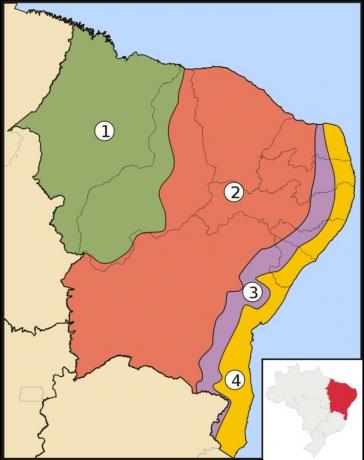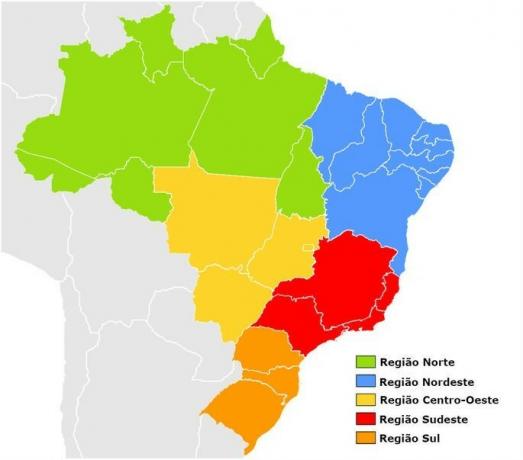Brazil has 3 geoeconomic regions, also called economic macroregions or regional complexes. They are: the Amazon, the Northeast and the Center-South.
This classification was drawn up in 1967 by geographer Pedro Pinchas Geiger, considering that these regions have very distinct natural, historical, human, social and economic aspects.
To better understand the location of each of them, see the map below:

1. Amazon geoeconomic region
States coveredAttractions: Amazonas, Acre, Rondônia, Roraima, Pará, Amapá, Tocantins, western Maranhão and much of Mato Grosso.
General information: largest macroeconomic region and covering about 60% of the national territory. It has a low population density, housing less than 10% of the country's population, making it the least developed region of all. In this regional complex is located the Amazon Forest, the largest tropical forest in the world.
Social and economic problems: poor income distribution and lack of access to health and education.
Most prominent cities: Manaus and Belém.
Main economic activities: agriculture and livestock, plant extraction, mining, industry (especially the Manaus free trade zone).
2. Center-south geoeconomic region
States covered: small part of southern Mato Grosso and southern Tocantins, Mato Grosso do Sul, Goiás, large part Minas Gerais, Espírito Santo, São Paulo, Rio de Janeiro, Paraná, Santa Catarina and Rio Grande do South.
General information: second largest macroeconomic region covering about 25% of the national territory. It is the most urbanized and populous region of all, home to around 70% of the Brazilian population. Of the regional complexes, it is the most developed, with high levels of social and economic development with good access to health and education.
Social and economic problems: poor income distribution, high unemployment rates, slums and social inequality.
Most prominent cities: São Paulo, Rio de Janeiro, Brasília, Curitiba and Belo Horizonte.
Main economic activities: agriculture, mining, oil exploration and industry.
3. Northeast geoeconomic region
States covered: eastern part of Maranhão, Piauí, Ceará, Rio Grande do Norte, Paraíba, Pernambuco, Alagoas, Sergipe, Bahia and a portion of northern Minas Gerais.
General information: smallest macroeconomic region that covers about 15% of the national territory and is home to 20% of the Brazilian population. Of the three regional complexes, it is the only one that is divided into 4 sub-regions due to the contrasts existing in each one of them. They are: Mid North, Sertão, Agreste and Zona da Mata.

Social and economic problems: poor income distribution, which generates several social problems, such as poverty, illiteracy, slums and violence.
Most prominent cities: Fortaleza, Salvador, Recife and São Luís.
Main economic activities of each sub-region:
- Middle north: agriculture, livestock and plant extraction.
- Sertão: agriculture and livestock.
- Agreste: agriculture, livestock and industry.
- Zona da Mata: agriculture, oil exploration and industry.
Geoeconomic Regions and Regional Division of Brazil
Unlike the classification of geoeconomic regions, which disregards state boundaries, the official regional division of Brazil comprises 5 regions: North, Northeast, Midwest, Southeast and South. These are determined by the political-administrative limits of the federation units.

Read too:
- Brazilian Regions
- Brazil states
- Brazil's map
Bibliographic references
Brazilian Institute of Geography and Statistics - IBGE
Brazilian Institute of Geography and Statistics. School geographic atlas. Rio de Janeiro: IBGE, 2002.

